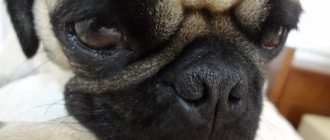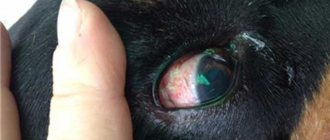Eye loss in dogs, or proptosis, is a dangerous pathology that can lead to loss of vision. Some breeds are more likely to experience this disease than others. The peculiarities of their anatomical structure are to blame for this. Owners of such pets should exercise increased caution and attentiveness, since a collision with one of the provoking factors can result in serious consequences.
Is eye loss in dogs literal?
It is important to note that eyeball prolapse in dogs should be understood figuratively and not literally. In fact, the organ itself still remains inside the eye socket, but is displaced from its original position and comes out from under the eyelids. Because of this, it seems that it is about to fall out.
When the position of the eyeball changes, its cornea, conjunctiva and retina are most vulnerable to external factors. Without timely help, their tissues begin to die, leading to partial and then complete loss of visual function.
Why do dogs' eyes fall out?
The most common cause of proptosis in small breeds is a fight with a large dog. The larger animal tries to grab the small throat by grabbing the withers. When, after a seizure, a large dog begins to pull the baby's skin above the head, the eyeball falls out.
The problem is more common in brachycephalic breeds. Some of them have eyes so poorly recessed into the socket that damage can occur even during normal play between two puppies. In addition to the shallow eye socket, they have excessively large eyelid openings. Therefore, any tension in the skin above the head or neck can cause the eye to fall out.
The second common cause is blunt head trauma. It could be:
- hit on the head with any object;
- collision with a motorcycle.
Accidentally hitting your head when falling or tripping can also lead to the same result. In this case, the only way to protect against injury is by organizing walks in places where the dog cannot bump into something and get injured.
Why does hair loss occur?
A dog's eyes fall out due to exposure to certain factors. These include:
- ophthalmological pathologies complicated by muscle weakness and tissue distortion;
- mechanical injuries to the eyes, vertebrae in the neck or temporal bone;
- insect bites that cause an acute allergic reaction;
- stress, high temperatures and infections accompanied by pressure changes;
- active jumps on high surfaces;
- a tight-fitting collar, which increases the likelihood of injury when the leash is pulled sharply;
- prolonged constipation, forcing the animal to constantly push;
- grabbing by the scruff of the neck in adulthood (this action is only safe for puppies with light weight);
- neglect of hygiene.
Due to non-compliance with prevention, not only a pet at risk, but also a completely ordinary dog can suffer from proptosis. For this reason, all owners of four-legged pets need to know the main symptoms of a dangerous pathology.
Prevention
Taking care of your eyes is the best preventative measure. Excessive physical stress on the visual muscles is undesirable. When playing sports, you must be careful and work carefully with large weights. If possible, hazardous activities are excluded from everyday life. Regular examinations by an ophthalmologist are carried out, and surgeons perform preventive operations that reduce the possibility of secondary prolapse.
Author's rating
Author of the article
Alexandrova O.M.
Articles written
2029
about the author
Was the article helpful?
Rate the material on a five-point scale!
( 2 ratings, average: 5.00 out of 5)
If you have any questions or want to share your opinion or experience, write a comment below.
Dog breeds that have eye loss
The most vulnerable breeds include brachycephalic dogs. These animals are easily recognized by their wide, flattened muzzle and bulging eyes. Their anatomical structure differs from other tetrapods:
- the absence of brow ridges that perform a protective function;
- shallow fundus and excessively large eyelid openings, increasing the likelihood of injury;
- weak muscles of the eyeballs that cannot cope with their main function.
In addition to proptosis, such pets often suffer from entropion and other ophthalmological diseases. Most injuries are acquired during puppyhood during play.
All these nuances must be taken into account before purchasing an animal in order to prepare in advance for possible difficulties. The dog breeds that are most likely to experience eye loss include:
- bulldogs;
- Shar Pei;
- Japanese Chins;
- chihuahua;
- Pekingese;
- bullmastiffs;
- Boston Terriers;
- Shih Tzu;
- pugs;
- boxers.
All other four-legged pets are subject to this pathology much less frequently - all thanks to the presence of brow ridges, fairly deep eye sockets and the correct structure of the skull. Almost all hunting dogs have these features.
Eye diseases
Some inflammatory eye diseases can also lead to serious consequences in the form of leakage of the eyeball. For example, this applies to endophthalmitis. When it occurs, the internal structures of the eyeball become inflamed, which leads to the accumulation of pus in the vitreous body. Treatment of endophthalmitis is possible only under the supervision of a doctor with the help of antibiotics.
It is also worth noting that in rare cases, completely harmless eye diseases, for example, conjunctivitis, barley or dacryocystitis, can lead to eye leakage. This is possible in a situation where infection penetrates into the eye membranes. Therefore, in any case, we recommend that you be more attentive to the health of your eyes and treat even the simplest diseases under the supervision of a doctor. This will help maintain good vision for many years.
MagazinLinz.ru team
What to do if your dog's eye falls out?
If a dog's eye has fallen out, it must be taken to the veterinarian. Only 30 minutes are allotted for this, so there is a high probability that you will have to provide first aid yourself. To do this you need:
- Eliminate all extraneous factors that could worsen the animal’s condition. Place your pet in a comfortable position and try to calm him down. Remember that in the current situation you cannot panic. Your emotions will quickly be transferred to the victim.
- Prevent recurrent damage. Put a protective collar on your dog or supervise all his actions. Avoid any attempt to scratch.
- Treat the affected eye to remove dirt and secretions. Clean the mucous membrane with a lint-free cotton pad soaked in antiseptic. Then moisten it with saline solution and lubricate it with eye ointment. Avoid using harsh medications with alcohol and cotton wool. They can cause burns and new injuries due to the abundance of sharp fibers.
- Reduce swelling. Apply ice wrapped in thick cloth to the affected area: 10 minutes will be enough, since too much exposure to cold can result in tissue hypothermia.
Please note that self-reduction is not permitted. This can only be done under general anesthesia, so avoid feeding until you see your veterinarian.
First alarming symptoms
If you have never encountered proptosis in practice, be sure to familiarize yourself with its symptoms. It includes the following features:
- photophobia (the pet constantly squints and hides in dark corners);
- dry cornea;
- pinching of the eyeball by the eyelid;
- profuse lacrimation (there may be traces of blood in the discharge);
- swelling of the conjunctiva and adjacent tissues;
- frequent blinking and scratching of the disturbing area;
- anxiety and depression, accompanied by periodic whining due to pain or other unpleasant sensations.
The victim should be taken to a veterinary clinic within 24 hours. After this time, the likelihood of complications increases, worsening the prognosis for recovery even after surgery.
The most common consequences of proptosis include the following:
- strabismus;
- cataract and glaucoma;
- loss of visual acuity;
- degenerative changes within the retina or its detachment;
- optic nerve atrophy;
- keratitis, uveitis and conjunctivitis;
- corneal ulcer;
- increased pressure inside the eyeballs.
The worst case scenario is blindness. Its appearance is characteristic of complete atrophy of the tissue inside the damaged eye. The only treatment for this complication is organ excision.
Contacting a veterinarian and treatment
During the examination, the veterinarian should examine the damaged eyeballs and check the integrity of the nerves. Based on what he saw, he can offer 2 options for surgical treatment: reduction or removal. In both cases, the intervention is performed under general anesthesia using anesthetics and painkillers.
Surgical intervention for reduction includes the following steps:
- Cleansing the eye of accumulated exudate, tear fluid and dirt.
- Trimming or dissecting the outer corner of the eye (external commissure of the eyelids) with a scalpel, followed by administration of drugs behind the eyeball.
- Direct reduction of the prolapsed organ with a napkin treated with tetracycline ointment.
- Applying a special bandage, lubricated with antimicrobial ointment, and sutures to the operated eyelids.
The rehabilitation period takes 15-30 days. 10 days after the operation, the bandage is replaced with a new one, re-treated with antiseptics and antibiotics.
Please note that removing sutures without the approval and involvement of a veterinarian is prohibited. This can lead to complications:
- granulating ulcer;
- cataracts;
- neuritis or optic nerve pigmentation.
For the safety of your pet, monitor the condition of his eyelids. If swelling, bleeding or purulent discharge occurs, be sure to seek help without waiting for your scheduled appointment.
Complications and consequences
Optic nerve atrophy occurs when the diagnosis is incorrect. Exophthalmos cannot be cured because the main cause of the disorder is not eliminated.
Possible complications:
- insufficient hydration leads to dry eye tissue;
- pressure on the optic nerve complicates visual perception;
- damage to muscle tissue limits the movement of the eyeball.
The most severe complication is loss of vision.











